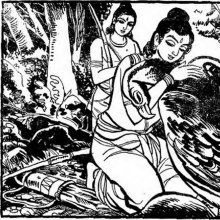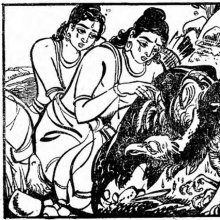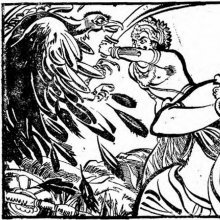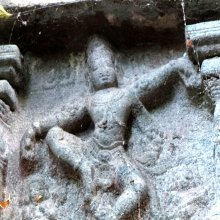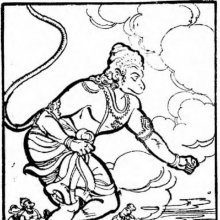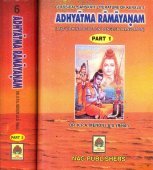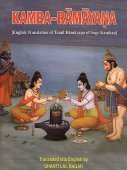Jatayu, Jaṭāyu, Jatāyū: 22 definitions
Introduction:
Jatayu means something in Hinduism, Sanskrit, Jainism, Prakrit, Marathi, biology, Tamil. If you want to know the exact meaning, history, etymology or English translation of this term then check out the descriptions on this page. Add your comment or reference to a book if you want to contribute to this summary article.
Images (photo gallery)
In Hinduism
Vaishnavism (Vaishava dharma)
Source: ISKCON Press: GlossaryJaṭāyu (जटायु).—A devotee of Lord Rāmacandra who was the king of the vultures, and the brother of Sampāti. He fought with the demon Rāvaṇa when the latter kidnapped Sītā, the consort of Lord Rāmacandra.
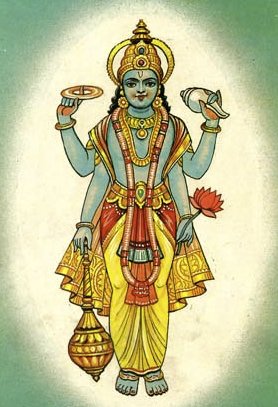
Vaishnava (वैष्णव, vaiṣṇava) or vaishnavism (vaiṣṇavism) represents a tradition of Hinduism worshipping Vishnu as the supreme Lord. Similar to the Shaktism and Shaivism traditions, Vaishnavism also developed as an individual movement, famous for its exposition of the dashavatara (‘ten avatars of Vishnu’).
Purana and Itihasa (epic history)
Source: archive.org: Puranic EncyclopediaJaṭāyu (जटायु).—A bird famous in the Purāṇas. Genealogy. Descended from Viṣṇu as follows, Brahmā—Marīci—Kaśyapa—Aruṇa—Jaṭāyu. (See full article at Story of Jaṭāyu from the Puranic encyclopaedia by Vettam Mani)
Source: Cologne Digital Sanskrit Dictionaries: The Purana Index1a) Jaṭāyu (जटायु).—A son of Aruṇa and Gṛdhri (Syeni, Vāyu-purāṇa) brought forth sons Kaka, Gṛdhra and Aśvakarṇi; king of vultures and younger brother of Sampāti;1 father of Karṇikāra and Śatagāmi;2 Dahanakriya of, done by Rāma; attained release by satsaṅga.3
- 1) Brahmāṇḍa-purāṇa III. 7. 447-48.
- 2) Matsya-purāṇa 6. 35-6.
- 3) Bhāgavata-purāṇa IX. 10. 12; XI. 12. 6; Vāyu-purāṇa 69. 326-7.
1b) Mountain a hill in Himālayas, the birth-place of Jaṭāmāli of the 19th dvāpara.*
- * Vāyu-purāṇa 23. 186.
Jaṭāyu (जटायु), an old eagle, is taking rest on a tree, hears her helpless cry. He realizes that she is the daughter-in-law of his old friend Daśaratha. In spite of his old age, the bird hurries to help her. A fight ensues between the old bird and the ten-headed mighty demon. The eagle is no match to the force of the demon. The latter leaves Jaṭāyu in a pool of blood by cutting its wings. Jaṭāyu in agony is waiting for Rāma. In search of Sītā, Rāma with his brother Lakṣmaṇa arrives there. They find the poor bird in a pool of blood. Jaṭāyu relates to him the whole story and breathes his last. In the Rāmāyaṇa by Vālmīki, it is mentioned that, Jaṭāyu being their family friend, Rāma performed the necessary funeral rites to the bird.
Source: JatLand: List of Mahabharata people and placesJaṭāyu (जटायु) is a name mentioned in the Mahābhārata (cf. I.60.67) and represents one of the many proper names used for people and places. Note: The Mahābhārata (mentioning Jaṭāyu) is a Sanskrit epic poem consisting of 100,000 ślokas (metrical verses) and is over 2000 years old.

The Purana (पुराण, purāṇas) refers to Sanskrit literature preserving ancient India’s vast cultural history, including historical legends, religious ceremonies, various arts and sciences. The eighteen mahapuranas total over 400,000 shlokas (metrical couplets) and date to at least several centuries BCE.
Kavya (poetry)
Source: Wisdom Library: KathāsaritsāgaraJaṭāyu (जटायु) or Jaṭāyus was slain by Rāvaṇa, according to in the Kathāsaritsāgara, chapter 51. Accordingly, “... there Rāvaṇa carried off his beloved Sītā by magic, and took her to the city of Laṅkā, having slain Jaṭāyu on the way”.
The story of Jaṭāyu was narrated by the Vidyādharī Kāñcanaprabhā to Naravāhanadatta while in a Svayambhū temple of Śiva, in order to demonstrate that “people who possess firmness endure for a long time mutual separation to which no termination is assigned”, in other words, that “heroic souls endure separation for so long a time”.
The Kathāsaritsāgara (‘ocean of streams of story’), mentioning Jaṭāyu, is a famous Sanskrit epic story revolving around prince Naravāhanadatta and his quest to become the emperor of the vidyādharas (celestial beings). The work is said to have been an adaptation of Guṇāḍhya’s Bṛhatkathā consisting of 100,000 verses, which in turn is part of a larger work containing 700,000 verses.

Kavya (काव्य, kavya) refers to Sanskrit poetry, a popular ancient Indian tradition of literature. There have been many Sanskrit poets over the ages, hailing from ancient India and beyond. This topic includes mahakavya, or ‘epic poetry’ and natya, or ‘dramatic poetry’.
Ayurveda (science of life)
Rasashastra (Alchemy and Herbo-Mineral preparations)
Source: Wisdom Library: Rasa-śāstraJaṭāyu (जटायु) or Jaṭāyulauha is the name of a Ayurvedic recipe defined in the fifth volume of the Rasajalanidhi (chapter 17, Medas: obesity). These remedies are classified as Iatrochemistry and form part of the ancient Indian science known as Rasaśāstra (medical alchemy). However, since it is an ayurveda treatment it should be taken with caution and in accordance with rules laid down in the texts.
Accordingly, when using such recipes (e.g., jaṭāyu-lauha): “the minerals (uparasa), poisons (viṣa), and other drugs (except herbs), referred to as ingredients of medicines, are to be duly purified and incinerated, as the case may be, in accordance with the processes laid out in the texts.” (see introduction to Iatro chemical medicines)

Āyurveda (आयुर्वेद, ayurveda) is a branch of Indian science dealing with medicine, herbalism, taxology, anatomy, surgery, alchemy and related topics. Traditional practice of Āyurveda in ancient India dates back to at least the first millenium BC. Literature is commonly written in Sanskrit using various poetic metres.
General definition (in Hinduism)
Source: Apam Napat: Indian MythologyJatyu was the son of Syeni who was a daughter of Daksha. The sage Kashyapa was his father. He succeeded to the kingship of the birds from his elder half-brother Sampati, when Sampati's wings were burnt away by the sun while trying to shield Jatayu.
He tried to stop Ravana from kidnapping Sita the wife of Rama. (This episode is narrated in Ramayana). Ravana cut off his wing and left him close to death. He held on to his life till Rama came by, and then died. Rama accepted him as his elder brother and performed the funeral rites for this great bird.
Source: WikiPedia: Hinduism1) In the Hindu epic Ramayana, Jatayu is the son of Aruṇa and nephew of Garuda. A demi-god who has the form of a vulture, he was an old friend of Dasharatha (Rama's father). He tries to rescue Sita from Ravana when Ravana is on his way to Lanka after kidnapping Sita. Jatayu fought valiantly with Ravana, but as Jatayu was very old Ravana soon got the better of him. As Rama and Lakshmana chanced upon the stricken and dying Jatayu in their search for Sita, he informs them of the fight between him and Ravana and the direction in which Ravana had gone (i.e., south).
2) Jatāyū (जटायू): Jatāyū was king of all the eagles-tribes, the son of Aruna and nephew of Garuda. A demi-god who has the form of an (eagle), he tries to rescue Sita from Ravana, when Ravana is on his way to Lanka after kidnapping Sita. His brother was Sampatī
Etymology: Jatayu (Sanskrit: जटायुः Jatāyu, Tamil: Chatayu, Thai: Sadayu, Malay: Jentayu or Chentayu), Indonesian: Burung Jatayu which means Jatayu Bird
In Jainism
General definition (in Jainism)
Source: archive.org: TrisastisalakapurusacaritraJaṭāyu (जटायु) is the name of a Bird previously known as Gandha, according to the Jain Ramayana and chapter 7.5 [The kidnapping of Sītā] of Hemacandra’s 11th century Triṣaṣṭiśalākāpuruṣacaritra: an ancient Sanskrit epic poem narrating the history and legends of sixty-three illustrious persons in Jainism.—Accordingly, “[...] When [Gandha] had regained consciousness, he fell at the Sādhu’s feet and was cured instantly by the magic art, the healing herb of touch, of the Sādhu. His wings became golden; his bill resembled coral; his feet were like rubies; and his body had the color of various jewels; his top-knots on his head resembled rows of pearls; and from that time the bird’s name was Jaṭāyus”.

Jainism is an Indian religion of Dharma whose doctrine revolves around harmlessness (ahimsa) towards every living being. The two major branches (Digambara and Svetambara) of Jainism stimulate self-control (or, shramana, ‘self-reliance’) and spiritual development through a path of peace for the soul to progess to the ultimate goal.
Biology (plants and animals)
Source: Google Books: CRC World Dictionary (Regional names)Jatayu in India is the name of a plant defined with Commiphora mukul in various botanical sources. This page contains potential references in Ayurveda, modern medicine, and other folk traditions or local practices It has the synonym Commiphora mukul (Hook. ex Stocks) Engl. (among others).
Example references for further research on medicinal uses or toxicity (see latin names for full list):
· Journal of the American Medical Association (2003)
· Complementary Therapies in Medicine (2009)
· Monographiae Phanerogamarum (1883)
· Hooker’s Journal of Botany Kew Gard. Misc. (1849)
· The Annals of Pharmacotherapy
· Complementary Therapies in Medicine (2005)
If you are looking for specific details regarding Jatayu, for example pregnancy safety, health benefits, chemical composition, diet and recipes, extract dosage, side effects, have a look at these references.

This sections includes definitions from the five kingdoms of living things: Animals, Plants, Fungi, Protists and Monera. It will include both the official binomial nomenclature (scientific names usually in Latin) as well as regional spellings and variants.
Languages of India and abroad
Marathi-English dictionary
Source: DDSA: The Molesworth Marathi and English Dictionaryjaṭāyu (जटायु).—m S A fabulous bird recorded in the rāmāyaṇa.
Marathi is an Indo-European language having over 70 million native speakers people in (predominantly) Maharashtra India. Marathi, like many other Indo-Aryan languages, evolved from early forms of Prakrit, which itself is a subset of Sanskrit, one of the most ancient languages of the world.
Sanskrit dictionary
Source: DDSA: The practical Sanskrit-English dictionaryJaṭāyu (जटायु).—m. A son of Śyeni and Aruṇa, a semi divine bird [ He was a great friend of Daśaratha. He once saved his life while he was thrown down along with his car by Saturn against whom he had proceeded when a drought, said to be caused by the planet, well-nigh devastated the earth. While Rāvaṇa was carrying away Sītā, Jaṭāyu heard her cries in the chariot and fought most desperately with the formidable giant to rescue her from his grasp. But he was mortally wounded, and remained in that state till Rāma passed by that place in the course of his search after Sītā. The kind-hearted bird told Rāma that his wife had been carried away by Rāvaṇa and then breathed his last. His funeral rites were duly performed by Rāma and Lakṣmaṇa.]
Derivable forms: jaṭāyuḥ (जटायुः).
See also (synonyms): jaṭāyus.
Source: Cologne Digital Sanskrit Dictionaries: Shabda-Sagara Sanskrit-English DictionaryJaṭāyu (जटायु).—m.
(-yuḥ) 1. A fabulous bird, the son of Aruna, killed by Ravana. 2. Bdellium. E. jaṭā accumulation, āyu or āyus life; long-lived; hence also jaṭāyus m. (-yuḥ) jaṭāṃ yāti yā-ku-jaṭā-ūrṇā yuc vā, jaṭa saṃhatau ac, jaṭaṃ saṃhatam āyuḥ asya vā .
Source: Cologne Digital Sanskrit Dictionaries: Benfey Sanskrit-English DictionaryJaṭāyu (जटायु).— and jaṭāyus ja- ṭāyus, m. A fabulous vulture, [Rāmāyaṇa] 1, 1, 51.
Source: Cologne Digital Sanskrit Dictionaries: Cappeller Sanskrit-English DictionaryJaṭāyu (जटायु).—[masculine] [Name] of a fabulous vulture.
Source: Cologne Digital Sanskrit Dictionaries: Monier-Williams Sanskrit-English Dictionary1) Jaṭāyu (जटायु):—[from jaṭa] m. Name of the king of vultures (son of Aruṇa and Śyenī, [Mahābhārata]; son of Garuḍa, [Rāmāyaṇa]; younger brother of Sampāti; promising his aid to Rāma, out of regard for his father Daśa-ratha, but defeated and mortally wounded by Rāvaṇa on attempting to rescue Sītā), [Mahābhārata i, 2634; iii, 16043ff. and 16242ff; Rāmāyaṇa i, iii f.]
2) [v.s. ...] Name of a mountain, [Vāyu-purāṇa i, 23, 176]
3) [v.s. ...] bdellium, [cf. Lexicographers, esp. such as amarasiṃha, halāyudha, hemacandra, etc.]
Source: Cologne Digital Sanskrit Dictionaries: Yates Sanskrit-English DictionaryJaṭāyu (जटायु):—(yuḥ) 2. m. A fabulous bird killed by Rāvana; bdellium.
Source: DDSA: Paia-sadda-mahannavo; a comprehensive Prakrit Hindi dictionary (S)Jaṭāyu (जटायु) in the Sanskrit language is related to the Prakrit words: Jaḍāu, Jaḍāuṇa.
[Sanskrit to German]
Sanskrit, also spelled संस्कृतम् (saṃskṛtam), is an ancient language of India commonly seen as the grandmother of the Indo-European language family (even English!). Closely allied with Prakrit and Pali, Sanskrit is more exhaustive in both grammar and terms and has the most extensive collection of literature in the world, greatly surpassing its sister-languages Greek and Latin.
Tamil dictionary
Source: DDSA: University of Madras: Tamil LexiconJaṭāyu (ஜடாயு) noun < Jaṭāyu. A vulture-king. See சடாயு. [sadayu.]
Tamil is an ancient language of India from the Dravidian family spoken by roughly 250 million people mainly in southern India and Sri Lanka.
See also (Relevant definitions)
Starts with: Jatayulauha, Jatayurkuli, Jatayus.
Full-text (+25): Arunatmaja, Sampati, Jatayus, Gridhrapati, Pakshiraj, Gridhraraja, Patageshvara, Pakshiraja, Gridhraraj, Catayu, Shyaineya, Pakshipumgava, Aruna, Pakshindra, Shatagami, Kutayu, Karnikara, Ratnashikhanda, Jadauna, Jadau.
Relevant text
Search found 28 books and stories containing Jatayu, Jadaayu, Jadayu, Jaṭāyu, Jatāyū, Jaṭāyū; (plurals include: Jatayus, Jadaayus, Jadayus, Jaṭāyus, Jatāyūs, Jaṭāyūs). You can also click to the full overview containing English textual excerpts. Below are direct links for the most relevant articles:
Hanuman Nataka (critical study) (by Nurima Yeasmin)
Hanuman-Nāṭaka, Act 4 (Summary) < [Chapter 3]
Hanuman-Nāṭaka, Act 5 (Summary) < [Chapter 3]
9.4. The character of Rāvaṇa < [Chapter 4]
List of Mahabharata people and places (by Laxman Burdak)
Trishashti Shalaka Purusha Caritra (by Helen M. Johnson)
Part 9: Rāma’s grief < [Chapter X - Rāma’s mokṣa (emancipation)]
Part 9: Story of Jaṭāyus < [Chapter V - The kidnapping of Sītā]
Part 1: Restoration of Pātālalaṅkā to Virādha < [Chapter VI - Bringing news of Sītā]
Puranic encyclopaedia (by Vettam Mani)
Animal Kingdom (Tiryak) in Epics (by Saranya P.S)
Chapter 3.2 - The story of Jatayu (Bird characters, part 2)
Chapter 2.4 - The genesis of animals and birds in Ramayana
Chapter 3.3 - The story of Sampati (Bird characters, part 3)
Ramayana of Valmiki (by Hari Prasad Shastri)
Chapter 51 - The Combat between Jatayu and Ravana < [Book 3 - Aranya-kanda]
Chapter 56 - The Intervention of Sampati < [Book 4 - Kishkindha-kanda]
Chapter 61 - Sampati tells his Story to the Sage Nishakara < [Book 4 - Kishkindha-kanda]
Related products
